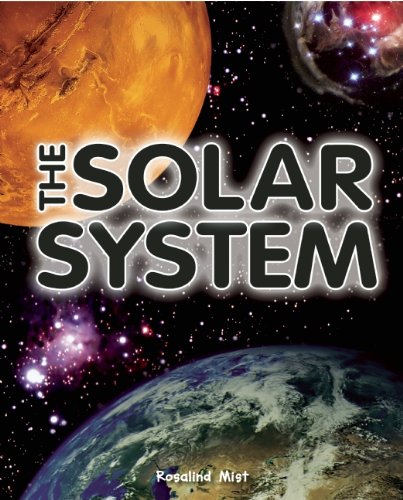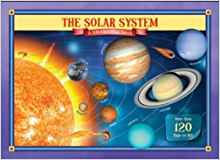-
The Solar System
Rosalind Mist
Paperback (QEB Publishing, Aug. 12, 2014)Explore the solar system with this exciting bind-up visual guide.With informative diagrams and NASA photography, the up-to-date text informs children about basic astronomy.Each planet, star, or space object is looked at in detail, as are developments in space technology, discoveries, and astronomers. P
P
-
The Solar System
Carmen Bredeson
Paperback (Scholastic, March 15, 2003)This Rookie read-About (r) Science book introduces young readers to the solar system. Colorful photos and simple text encourage children to read on their own as they learn about the planets, comets, asteroids, and other objects that circle the Sun. (Also available: Astronauts, Liftoff!, and The Moon) K
K
-
The Story of the Solar System
George F. Chambers
eBookBy the term “Solar System” it is to be understood that an Astronomer, speaking from the standpoint of an inhabitant of the Earth, wishes to refer to that object, the Sun, which is to him the material and visible centre of life and heat and control, and also to those bodies dependent on the Sun which circulate round it at various distances, deriving their light and heat from the Sun, and known as planets and comets. The statement just made may be regarded as a general truth, but as the strictest accuracy on scientific matters is of the utmost importance, a trivial reservation must perhaps be put upon the foregoing broad assertion. There is some reason for thinking that possibly one of the planets (Jupiter) possesses a little inherent light of its own which is not borrowed from the Sun; whilst of the comets it must certainly be said that, as a rule, they shine with intrinsic, not borrowed light. Respecting these reservations more hereafter.The planets are divided into “primary” and “secondary.” By a “primary” planet we mean one which directly circulates round the Sun; by a “secondary” planet we mean one which in the first instance circulates round a primary planet, and therefore only in a secondary sense circulates round the Sun. The planets are also “major” or “minor”; this, however, is only a distinction of size.The secondary planets are usually termed “satellites,” or, very often, in popular language, “moons,” because they own allegiance to their respective primaries just as our Moon—the Moon—does to the Earth. But the use of the term “moon” is inconvenient, and it is better to stick to “satellite.”There is yet another method of classifying the planets which has its advantages. They are sometimes divided into “inferior” and “superior.” The “inferior” planets are those which travel round the Sun in orbits which are inside the Earth’s orbit; the “superior” planets are those whose orbits are outside the Earth.The actual movements of the planets round the Sun are extremely simple, for they do nought else but go on, and on, and on, incessantly, always in the same direction, and almost, though not quite, at a uniform pace, though in orbits very variously inclined to the plane of the ecliptic. But an element of extreme complication is introduced into their apparent movements by reason of the fact that we are obliged to study the planets from one of their own number, which is itself always in motion.If the Earth itself were a fixture, the study of the movements of the planets would be a comparatively easy matter, whilst to an observer on the Sun it would be a supremely easy matter.Greatly as the planets differ among themselves in their sizes, distances from the Sun, and physical peculiarities, they have certain things in common, and it will be well to make this matter clear before we go into more recondite topics. For instance, not only do they move incessantly round the Sun in the same direction at a nearly uniform pace, but the planes of their orbits are very little inclined to the common plane of reference, the ecliptic, or to one another. The direction of motion of the planets as viewed from the north side of the ecliptic is contrary to the motion of the hands of a watch. Their orbits, unlike the orbits of comets, are nearly circular, that is, they are only very slightly oval. Agreeably to the principles of what is known as the Law of Universal Gravitation, the speed with which they move in their orbits is greatest in those parts which lie nearest the Sun, and least in those parts which are most remote from the Sun; in other words, they move quickest in Perihelion and slowest in Aphelion.
-
The Solar System.
Safrew & Thompson
Hardcover (Five Mile Press, Sept. 1, 2010)Explore the far reaches of our solar system with this life-a-flap book. Stunning images and fascinating facts about the planets that surround us, the stars, comets, and meteors. Lift the flaps on every page to discover more about our neighbors in the solar system.
-
The Solar System
Howard K. Trammel
Library Binding (Childrens Pr, Sept. 1, 2009)Introduces the solar system, describing how it was formed, its elements, including the Sun, the planets, meteroids, asteroids, and comets, and the telescopes and spacecrafts used in exploring it. S
S
-
Solar System, The
Colleen Sexton
Paperback (Bellwether Media, Jan. 1, 2016)The solar system is made up of planets, moons, asteroids, comets, meteoroids, and more. Young readers will learn about the bodies that make up the solar system and how they interact with each other. K
K
-
The Solar System
Brady Vaughan, Vimal Vachhani
Paperback (CreateSpace Independent Publishing Platform, June 25, 2018)Filled with colorful images and clever poems, The Solar System is a fun and educational tour through the celestial bodies in our solar systems. Read it to young children or let older children explore on their own, The Solar System will be valuable to all ages, even adults!
-
The Solar System
Colleen Sexton
Library Binding (Bellwether Media, Jan. 1, 2010)The solar system is made up of planets, moons, asteroids, comets, meteoroids, and more. Young readers will learn about the bodies that make up the solar system and how they interact with each other. P
P
-
THE SOLAR SYSTEM
Remedia Publications
language (Remedia Publications Inc., Nov. 13, 2019)Grade Level: 4-12Reading Level: 3-5Since the beginning of time, people have been captivated by objects in space. Early astronomers could only speculate about the nature of the universe. Today, with the help of sophisticated equipment, we know more. Students are sure to be fascinated by the interesting information found in this book about the sun, planets, and moon. The colorful photo of the planets will add to the appeal of learning about our solar system. Each story is followed by questions to test understanding as well as a research activity to extend learning. Accompanying each story is an activity page which requires the learner to use context clues to further demonstrate understanding. A great way to boost reading comprehension skills! 40 pages.
-
The Solar System
Carmen Bredeson
Library Binding (Childrens Pr, March 1, 2003)An introduction to the planets of our solar system and other features such as asteroids, meteoroids, comets, and moons. K
K
-
The Solar System
Carmen Bredeson
Paperback (Childrens Pr, Sept. 1, 2003)An introduction to the planets of our solar system and other features such as asteroids, meteoroids, comets, and moons. K
K
-
The Solar System
Howard K. Trammel
Paperback (Childrens Pr, March 1, 2010)This series explores Earth's solar system as well as galaxies, stars, and other objects in space. Each book reflects the latest research and will teach readers basic scientific principles that aid in understanding the workings of the universe. S
S